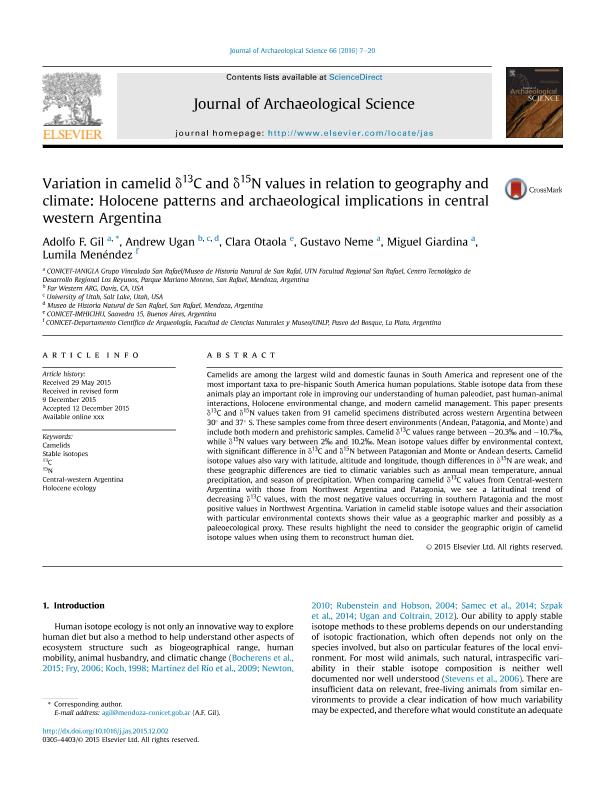Artículo
Variation in camelid δ13C and δ15N values in relation to geography and climate: Holocene patterns and archaeological implications in central western Argentina
Gil, Adolfo Fabian ; Ugan, Andrew; Otaola, Clara
; Ugan, Andrew; Otaola, Clara ; Neme, Gustavo Adolfo
; Neme, Gustavo Adolfo ; Giardina, Miguel Angel
; Giardina, Miguel Angel ; Menendez, Lumila Paula
; Menendez, Lumila Paula
 ; Ugan, Andrew; Otaola, Clara
; Ugan, Andrew; Otaola, Clara ; Neme, Gustavo Adolfo
; Neme, Gustavo Adolfo ; Giardina, Miguel Angel
; Giardina, Miguel Angel ; Menendez, Lumila Paula
; Menendez, Lumila Paula
Fecha de publicación:
02/2016
Editorial:
Academic Press Ltd - Elsevier Science Ltd
Revista:
Journal of Archaeological Science
ISSN:
0305-4403
Idioma:
Inglés
Tipo de recurso:
Artículo publicado
Clasificación temática:
Resumen
Camelids are among the largest wild and domestic faunas in South America and represent one of the most important taxa to pre-hispanic South America human populations. Stable isotope data from these animals play an important role in improving our understanding of human paleodiet, past human-animal interactions, Holocene environmental change, and modern camelid management. This paper presents δ13C and δ15N values taken from 91 camelid specimens distributed across western Argentina between 30° and 37° S. These samples come from three desert environments (Andean, Patagonia, and Monte) and include both modern and prehistoric samples. Camelid δ13C values range between -20.3‰ and -10.7‰, while δ15N values vary between 2‰ and 10.2‰. Mean isotope values differ by environmental context, with significant difference in δ13C and δ15N between Patagonian and Monte or Andean deserts. Camelid isotope values also vary with latitude, altitude and longitude, though differences in δ15N are weak, and these geographic differences are tied to climatic variables such as annual mean temperature, annual precipitation, and season of precipitation. When comparing camelid δ13C values from Central-western Argentina with those from Northwest Argentina and Patagonia, we see a latitudinal trend of decreasing δ13C values, with the most negative values occurring in southern Patagonia and the most positive values in Northwest Argentina. Variation in camelid stable isotope values and their association with particular environmental contexts shows their value as a geographic marker and possibly as a paleoecological proxy. These results highlight the need to consider the geographic origin of camelid isotope values when using them to reconstruct human diet.
Palabras clave:
13c
,
15n
,
Camelids
,
Central-Western Argentina
,
Holocene Ecology
,
Stable Isotopes
Archivos asociados
Licencia
Identificadores
Colecciones
Articulos(CCT - LA PLATA)
Articulos de CTRO.CIENTIFICO TECNOL.CONICET - LA PLATA
Articulos de CTRO.CIENTIFICO TECNOL.CONICET - LA PLATA
Articulos(CCT - MENDOZA)
Articulos de CTRO.CIENTIFICO TECNOL.CONICET - MENDOZA
Articulos de CTRO.CIENTIFICO TECNOL.CONICET - MENDOZA
Articulos(IANIGLA)
Articulos de INST. ARG. DE NIVOLOGIA, GLACIOLOGIA Y CS. AMBIENT
Articulos de INST. ARG. DE NIVOLOGIA, GLACIOLOGIA Y CS. AMBIENT
Articulos(IMHICIHU)
Articulos de INST.MULTIDISCIP.DE HISTORIA Y CS.HUMANAS
Articulos de INST.MULTIDISCIP.DE HISTORIA Y CS.HUMANAS
Citación
Gil, Adolfo Fabian; Ugan, Andrew; Otaola, Clara; Neme, Gustavo Adolfo; Giardina, Miguel Angel; et al.; Variation in camelid δ13C and δ15N values in relation to geography and climate: Holocene patterns and archaeological implications in central western Argentina; Academic Press Ltd - Elsevier Science Ltd; Journal of Archaeological Science; 66; 2-2016; 7-20
Compartir
Altmétricas



